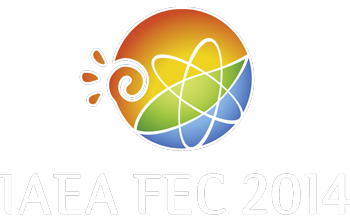Speaker
Mr
Vladimir Rozhdestvensky
(Ioffe-Institute)
Description
Results of studying the abnormal microwave emission (ME) arising under ohmic heating (OH) of the moderately dense plasma and generation of the low-hybrid current drive (LHCD) in the FT-2 tokamak are presented. The ME appearance is due to the «fan» instability development and the substantial local magnetic ripples existence. It was found that the ME arises continuously during OH in the frequency range (10 – 40)GHz and is accompanied by short, «gaint» flashes, which are greatly larger than the pedestal and have the narrow frequency spectrum. The synchrotron emission (SE) growth and less intensive flashes appear also in the range (57-75)GHz. As known they arise under the maser amplification of SE during interaction of AE with harmonics of magnetic ripples in the electron cyclotron autoresonance. Owing to the non-linear transformation of excited electron plasma waves into electromagnetic ones collective emission, CE, appears. It becomes possible the maser amplification of both SE and CE . The less intensive ME flashes arise apparently in the SE maser amplification only. The «gaint» flashes may be initiated under suitable conditions by transition of the maser – amplifier into the self–excitation regime, when the short powerful flashes of low-frequency coherent ME are generated. The plasma HF-pumping at the low-hybrid frequencies during the quazistationary OH stage provides the effective LHCD. The first high fast electron heating from 300 eV up to 550 eV at Phf = 90 kW was registered in this regime together with the radiation losses growth due to the SE intensity increase in the (53-156)GHz range. It was accompanied by short ME spikes of the maser nature observed in the more narrow frequency range (53 ÷ 78)GHz. The such ones were observed earlier under the plasma OH. It is possible this additional electron heating is due to the SE and spikes of ME absorbtion in the black plasma layers.
| Country or International Organisation | Russian Federation |
|---|---|
| Paper Number | EX/P1-28 |
Author
Mr
Vladimir Rozhdestvensky
(Ioffe-Institute)
Co-authors
Mr
Alexander Shevelev
(Ioffe - Institute)
Mr
Alexander Stepanov
(Ioffe - Institute)
Mr
Alexeiy Altukhov
(Ioffe - Institute)
Mr
Denis Kuprienko
(Ioffe - Institute)
Mr
Lev Esipov
(Ioffe - Institute)
Mr
Serguey Krikunov
(Ioffe - Institute)
Mr
Serguey Lashkul
(Ioffe - Institute)
Mr
Valeriy Dyachenko
(Ioffe - Institute)

